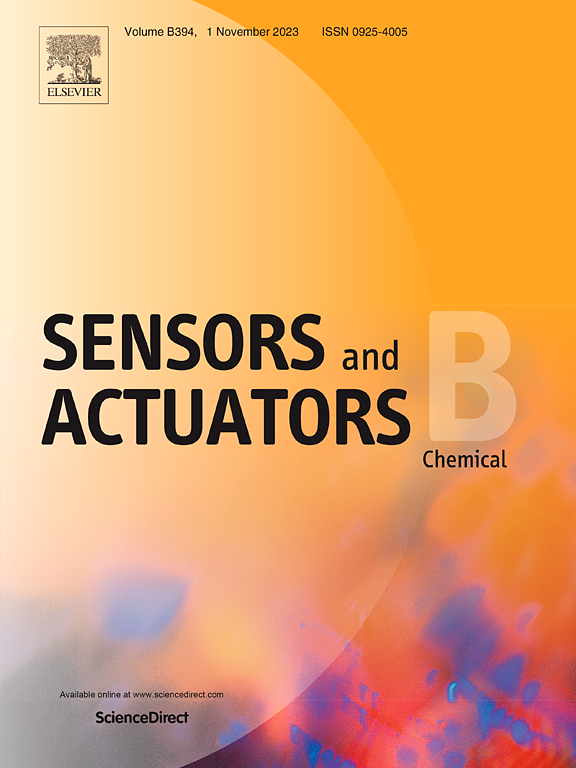在具有超大编码容量的悬浮阵列磁微球上立体组装dna染料分子
IF 8
1区 化学
Q1 CHEMISTRY, ANALYTICAL
引用次数: 0
摘要
荧光编码微球作为悬液阵列的核心元件,已成为一种流行的多指标生物检测技术。荧光材料在高浓度下的团聚和自猝灭效应是荧光编码微球编码容量不能提高的主要原因之一。为了克服这些缺点,本研究提出了一种将两个染料分子立体组装在磁性微球上制备荧光编码微球的方法。基于dna -染料分子类型和浓度的变化,该方法制备的两种颜色的相同粒径荧光微球的编码容量为104,是目前报道的最大的编码容量。这些编码微球在长期储存方面表现出优异的稳定性。选择两种荧光微球(即S4R5和S4R7)固定捕获的特异性抗体,同时检测经典肿瘤标志物,包括甲胎蛋白和癌胚抗原;通过流式细胞术进行“三明治”型免疫分析,证明了所开发的悬浮阵列同时检测多个靶标的能力。StayGold是一种绿色荧光蛋白,以探针标记的形式表达到检测抗体上。对于甲胎蛋白和癌胚抗原的检测,在1×101-1×105 pg/mL (R2 = 0.9915)和5×101-2.5×105 pg/mL (R2 = 0.9903)的宽线性范围内,分别满足3.7和7.8 pg/mL的检出限。该悬浮阵列检测系统在临床诊断、基因组学、蛋白质组学、环境监测和药物筛选等领域具有广阔的应用前景。本文章由计算机程序翻译,如有差异,请以英文原文为准。
Stereo-assembled DNA–dye molecules on magnetic microspheres with ultralarge coding capacity for suspension arrays
As the central element of suspension arrays, fluorescent-encoded microspheres have become a prevalent technology for multi-index organism detection. The agglomeration and self-quenching effect of fluorescent materials at high concentration is one of the main reasons the coding capacity of fluorescent coding microsphere fails to rise. To overcome these shortcomings, this study proposed a preparation method for fluorescent-encoded microspheres by stereo-assembling two dye molecules on magnetic microspheres. The coding capacity of fluorescent microspheres prepared by this developed method in the same particle size with two colors is 104 based on the variation of type and concentration of DNA–dye molecules, which is the largest coding capacity compared with that reported previously. These encoding microspheres exhibit excellent stability for long-term storage. Two kinds of fluorescent microspheres (i.e., S4R5 and S4R7) were chosen to fix specific captured antibodies for simultaneous detection of classical tumor markers, including alpha-fetoprotein and carcinoembryonic antigen; a “sandwich” type immunoassay via flow cytometry was used to demonstrate the ability of the developed suspension array to detect multiple targets simultaneously. StayGold, a kind of green fluorescent protein, was expressed as probe labeled onto detecting antibodies. For the detection of alpha-fetoprotein and carcinoembryonic antigen, we achieved a wide linear range of 1×101–1×105 pg/mL (R2 = 0.9915) and 5×101–2.5×105 pg/mL (R2 = 0.9903) while meeting the detection limits of 3.7 and 7.8 pg/mL, respectively. This developed suspension array detection system shows great alternative prospects in multiple analysis across various fields, including clinical diagnostics, genomics, proteomics, environmental monitoring, and drug screening.
求助全文
通过发布文献求助,成功后即可免费获取论文全文。
去求助
来源期刊

Sensors and Actuators B: Chemical
工程技术-电化学
CiteScore
14.60
自引率
11.90%
发文量
1776
审稿时长
3.2 months
期刊介绍:
Sensors & Actuators, B: Chemical is an international journal focused on the research and development of chemical transducers. It covers chemical sensors and biosensors, chemical actuators, and analytical microsystems. The journal is interdisciplinary, aiming to publish original works showcasing substantial advancements beyond the current state of the art in these fields, with practical applicability to solving meaningful analytical problems. Review articles are accepted by invitation from an Editor of the journal.
 求助内容:
求助内容: 应助结果提醒方式:
应助结果提醒方式:


